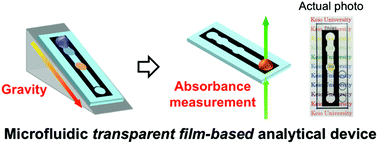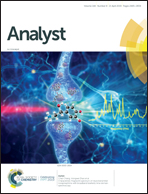Printed low-cost microfluidic analytical devices based on a transparent substrate†
Abstract
This work describes the development of a microfluidic analytical device prepared on a transparent OHP film substrate, named the microfluidic transparent film-based analytical device (μTFAD). Printing technologies including wax printing for microchannel patterning and inkjet printing for chemical assay component deposition have been employed for the μTFAD fabrication. The fully printed μTFAD allowed gravity-assisted pump-free transportation of the sample liquid (50 μL) and an absorbance measurement-based iron ion (Fe2+) assay using nitroso-PSAP as the colorimetric reagent within a wax-patterned microfluidic structure. By measuring absorbance values at the Fe2+-nitroso-PSAP complex-specific wavelength (756 nm), a response curve with a linear range of 0–200 μM was obtained. The limit of detection (1.18 μM) obtained with the proposed μTFADs was comparable to the results achieved with a conventional 96-well microplate assay (0.92 μM) and lower than that in the case of digital colour analysis-assisted filter paper spot tests (7.71 μM) or the absorbance analysis of refractive index-matched translucent filter paper spots (37.2 μM). In addition, highly selective Fe2+ detection has been achieved in the presence of potentially interfering metal ions (Cu2+, Co2+, Ni2+) without the use of any masking reagents, owing to the selection of the target complex-specific wavelength in the absorbance measurement on μTFADs.



 Please wait while we load your content...
Please wait while we load your content...